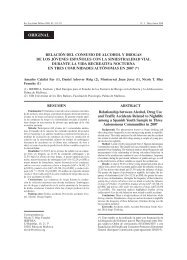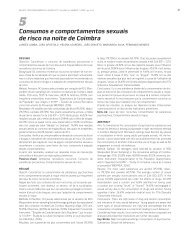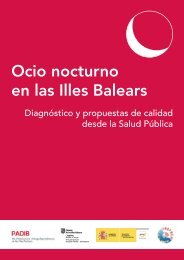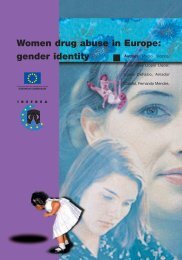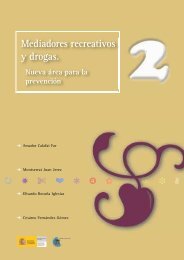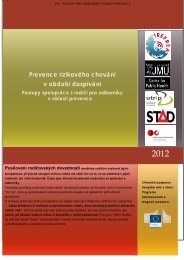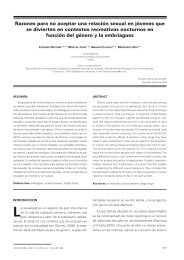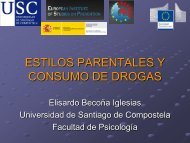Characteristics and social representation of ecstasy in Europe - Irefrea
Characteristics and social representation of ecstasy in Europe - Irefrea
Characteristics and social representation of ecstasy in Europe - Irefrea
Create successful ePaper yourself
Turn your PDF publications into a flip-book with our unique Google optimized e-Paper software.
The culturally sensitive poly-consumer model, represented <strong>in</strong> our survey by theUtrecht (Netherl<strong>and</strong>s) sample, where there is also a multi-use but where belong<strong>in</strong>g toone subgroup or another <strong>in</strong>fluences the preferred comb<strong>in</strong>ation <strong>of</strong> drugs. The type <strong>of</strong>preferred music, the way <strong>of</strong> dress<strong>in</strong>g, the age, etc <strong>and</strong> the comb<strong>in</strong>ation <strong>of</strong> preferreddrugs depends to the group we are study<strong>in</strong>g, even that it is always a polyconsumepattern. In this study the Dutch sample is represented ma<strong>in</strong>ly by the ‘mellow house’group.There is no doubt that there is yet a fourth model, for those countries (Sc<strong>and</strong><strong>in</strong>aviancountries, Greece...) where, at the present time, the use made <strong>of</strong> these substances is avery occasional one.ASSOCIATION WITH DANCINGThe relationship <strong>of</strong> danc<strong>in</strong>g with this drug is, as we know, frequently noted.Certa<strong>in</strong>ly, danc<strong>in</strong>g is the response most chosen by the C group (add<strong>in</strong>g together“enjoy<strong>in</strong>g danc<strong>in</strong>g” <strong>and</strong> “danc<strong>in</strong>g longer”) among the reasons for use. The percentagefluctuates between 32,5% (Nice) <strong>and</strong> 21,7% (Utrecht). In view <strong>of</strong> these data, we feelthat from the preventive po<strong>in</strong>t <strong>of</strong> view, the <strong>ecstasy</strong>-danc<strong>in</strong>g association is important butnot an exclusive one. Young people also associate <strong>ecstasy</strong> with other aspects so that onecan not work on a preventive policy centred exclusively on this association.Of course, House music is the one <strong>in</strong> all the sample, where we f<strong>in</strong>d a larger number<strong>of</strong> the C group than the NC group, exactly the opposite to what happens with rock, pop,salsa <strong>and</strong> ballads. Other types <strong>of</strong> music have a more irregular behaviour. The rave sceneonly has importance <strong>in</strong> some countries. The young <strong>in</strong> the Nice sample (29,6%) <strong>and</strong>those <strong>in</strong> Utrecht(20%) are the ones show<strong>in</strong>g a certa<strong>in</strong> frequency <strong>in</strong> go<strong>in</strong>g to this sort <strong>of</strong>event.IMPLIED REASONS ON WHY ECSTASY PRODUCES PROBLEMSThe effects <strong>of</strong> <strong>ecstasy</strong> are evaluated, <strong>in</strong> general, very positively by users, notably <strong>in</strong>Coimbra <strong>and</strong> Utrecht. In these cities, the fact that the samples showed the lowestfrequencies <strong>of</strong> use <strong>and</strong> there are few ex-users may have had some <strong>in</strong>fluenceAbout the results <strong>of</strong> the question about problems that they th<strong>in</strong>k can be caused by<strong>ecstasy</strong>, <strong>in</strong> all the samples, the NC responded <strong>in</strong> a similar way, opposite to the wayevaluated by the C groups. The NC score much lower all the possibilities <strong>in</strong> thequestionnaire with the exception <strong>of</strong> “unforeseeable effects” <strong>and</strong> “produces addiction”.This last item makes the biggest differences between the two groups. To give anexample, <strong>in</strong> Coimbra only 1,4% <strong>of</strong> the C group believes that <strong>ecstasy</strong> produces addictionaga<strong>in</strong>st 26,3% <strong>of</strong> the NC group. Even <strong>in</strong> Utrecht which has given the lowest overallpercentage, the difference between the C group (2,9%) <strong>and</strong> NC group (15,9%) isstrik<strong>in</strong>g. This po<strong>in</strong>t gives us <strong>in</strong>terest<strong>in</strong>g keys to the <strong>social</strong> <strong>representation</strong> <strong>of</strong> <strong>ecstasy</strong> -thispo<strong>in</strong>t will be enlarged below, when we refer to <strong>social</strong> <strong>representation</strong>- among the young,<strong>and</strong> the differences <strong>of</strong> this <strong>representation</strong> among consumers <strong>and</strong> non-consumers, with186



